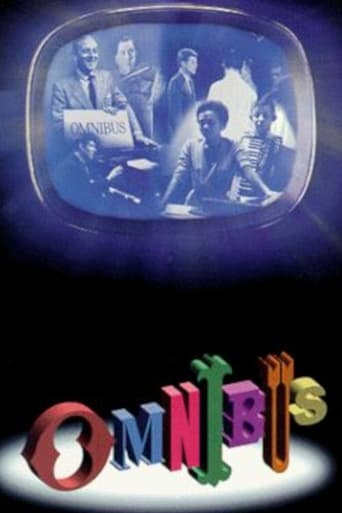

Am I Missing Something?
... View MoreFanciful, disturbing, and wildly original, it announces the arrival of a fresh, bold voice in American cinema.
... View MoreIt's a good bad... and worth a popcorn matinée. While it's easy to lament what could have been...
... View MoreThis is a small, humorous movie in some ways, but it has a huge heart. What a nice experience.
... View MoreWE LEARNED LONG ago with the earliest days of this series that OMNIBUS (Ford Foundation, 1952-61)means all encompassing. We can testify from first hand experience that it was, indeed that. In a typical season, it covered Classical Music, theatre, film, history, scientific discoveries, technology, biology, archeology and paleontology. And that's just what we can recall from our own memory.THE CREATIVE FORCE behind the program was Brit, Alistair Cooke. His mark is clearly evident throughout the series varying episodes. No matter the subject, there was no doubt that it was his version.THIS WAS DEFINITELY Mr. Cooke's show, stem to stern and it showed. The British born journalist (in the best tradition and sense of the word) would later become a naturalized American citizen. Inspite of a very cultured and "high class" sounding accent, his pedigree originated in the Bourgoise Middle class with his folks running a bed & breakfast (no doubt a sort of FAWLTY TOWERS of its day).AS WE HAVE previously stated, we believe that this Ford Foundation Sponsored creation may well have been the inspiration for the Public Broadcasting System. There does indeed appear to be some very convincing evidence to support our assertion. And this was long before the creation of the Corporation for Public Broadcasting, the National Endowment for the Arts, the National Endowment for the Humanities and the National Corporation for Wasting Taxpayer$ Money.NO SCHULTZ, NOT insertion!
... View MoreIn 1952, the Ford Foundation created two funds for educational television. One was for publicly supported TV, and it evolved into the modern PBS. The other was for commercial educational TV, and its chief product was the Omnibus TV series.Omnibus broadcast, initially, live from New York City at 4:00 PM on Sundays. It was hosted by Alistair Cooke (his first show in the US) and it featured a broad range of programming about science, the arts and the humanities. Virtually anyone of cultural interest who passed through New York might end up on the show. Film segments were integrated between live performances.Among the show's regular contributors were William Saroyan, who offered up numerous one-act plays and a six-part autobiographical work, and Cyril Ritchard and Helen Hayes, two of the Broadway theater's brightest lights, who appeared in a series of one-act plays together.Some of Omnibus' landmark shows include:"King Lear" starring Orson Welles, directed by Peter BrookeLeonard Bernstein's first TV appearance, where he explained the structure of Beethoven's 5th Symphony, with the orchestral score drawn on the studio floor so that the different instrumentalists could walk along it to visually show their contribution to the overall sound."The Moor's Pavanne," a rare (possibly unique?) record of Dancer/Choreographer Jose Limon in performance, featuring his ballet adaptation of Shakespeare's OthelloA Portrait of Grand Central Station, a fabulous live broadcast from the great temple of railroads, ending with Alistair Cook broadcasting via mobile transmitter from the engineer's cab of the 20th Century Limited as it headed for Chicago.Robert Flaherty's film, "The Louisiana Story"Omnibus was a cultural treasure trove. It is preserved on kinescope and videotape. I believe much of it can be seen at The Museum of Television and Radio (New York and Los Angeles). There is also a research collection at Wesleyan University in Connecticut.
... View More